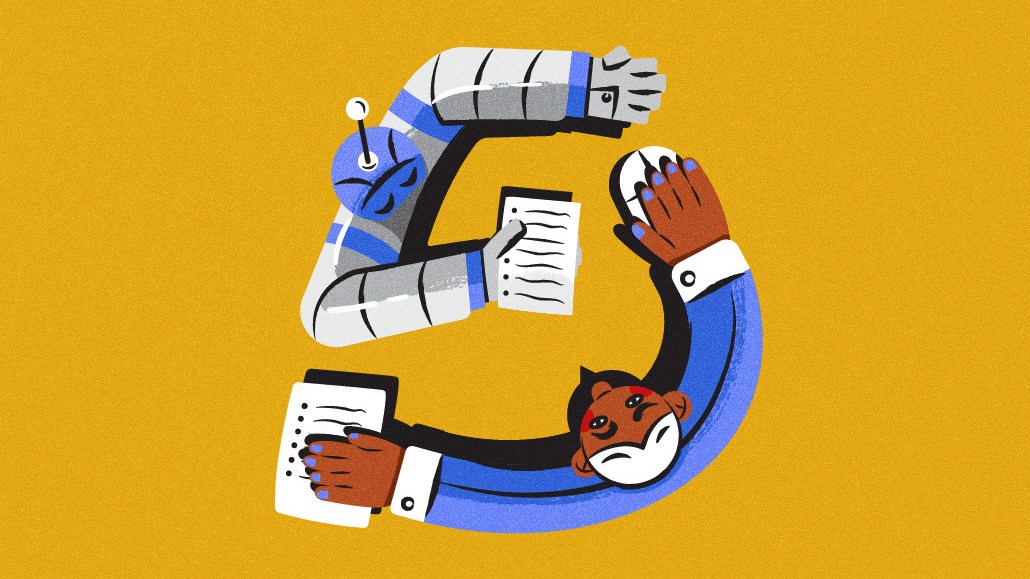Insights from CTV leaders at Dentsu, Horizon Media and more
Media Buying Briefing: What if ChatGPT could replace a media planner?

This Media Buying Briefing covers the latest in agency news and media buying for Digiday+ members and is distributed over email every Monday at 10 a.m. ET. More from the series →
Agencies are moving beyond generative artificial intelligence to examine its media planning capabilities – but it may not be ready to overtake those jobs just yet.
While much of the AI and ChatGPT attention has been around generative results and content creation, now a few agencies are taking a different approach to understand its business value in the long run. Some are experimenting with misinformation detection and brand safety tactics, while others are wondering whether AI can do the work of a media planner to support media buying and how these technologies can impact clients.
The media planner puzzle
In recent months, Nuno Andrade, chief innovation officer of performance-focused agency Media Culture, has been testing ChatGPT on media buying queries. In one client example with a math tutoring service targeting women 25-54 with children, he prompted the tool on which TV outlets to consider for audience insights analysis. The AI was able to identify four out of five of the top stations that the agency’s survey-based media planning tool provided, and gave some other channel and budget recommendations, as well.
“It was impressive,” Andrade said. “It was interesting that it was able to kind of nail down those in the top tier.”
The greater potential is in how AI can help planners save a lot of time and remove some of the “mind numbing” work required through research platforms, pulling surveys and other data that takes hours, Andrade explained. And in the future, it can be a way for agencies to train media teams into strategists who can leverage AI to enhance their skillset.
“From that standpoint, it’s not going to replace a senior planner … but it is going to take the role of those kinds of junior agency coordinators that come in and have to be trained in all these kinds of minutiae,” he added. “A lot of what I do is kind of overarching, what we call connections planning – meaning that we’re tying an audience to where they should be reached.”
Andrade said the agency is developing an internal project on creating a process for media planners that will help them use AI considerations in the mix and add context for their planning. Eventually it can help the smaller advertisers that may not have a lot of budget to work with larger agencies and get the expertise and service across TV, paid, search and social, he added.
Infrastructure and speed
Stagwell agency Code and Theory is also taking generative AI another step further: the long-term strategy has been focused on building infrastructure and framework for clients. Earlier this month, the agency partnered with Oracle to build new AI capabilities using its cloud infrastructure, with initial focus on the client base in financial, automotive, hospitality and retail industries.
The aim is eventually to help clients leverage AI in their sectors and change the existing business infrastructure, from using machine learning and generative AI to business intelligence and cloud services. To Dan Gardner, executive chairman and cofounder of Code and Theory, this collaboration offers a long-term approach to building a foundation for agencies to experiment with AI capabilities for clients.
“There’s a lot of talk about AI just in general, and people like rushing to do these topical use cases,” Gardner said. “But one of the most important things about AI is actually the computational power it takes to actually drive this forward.”
Gardner believes that generative AI and creative enablement can help with output, but for many businesses in CPG, finance or health care, there is a greater opportunity in digital transformation. “We think long term that’s where the real differentiation is, that has more effective staying power within a company to create a differentiation, versus a quick, generative campaign,” Gardner said. “If you transform an organization to actually have AI built into the organization from an enablement standpoint, it actually has a longer staying power.”
Similarly, Media.Monks has been exploring the ways AI can be applied across social media and other content applications. For instance, with more advanced translation tools and language models, there is potential to expand their audience reach and markets in other parts of the world.
Amy Luca, evp global head of social at the agency network, pointed to AI becoming a way to do more rapid A/B testing in the future. “Artificial intelligence is only intelligent because we’re the ones dictating we are the puppet masters, putting the inputs in and helping it learn,” Luca said. “So I think it’s going to be pretty revolutionary when it comes to especially high volume, performance-based media.”
For example, Luca said Media.Monks is currently launching an international e-commerce client in the U.S., and while teams can take their “best educated guess” in targeting, products and other parameters – they can only work so fast.
“But we have to be able to iterate faster and better on some of that stuff — mundane tasks looking at [whether something worked or not], and if this headline is tracking,” Luca added. “But a lot of it is reducing friction points, things that block us from moving faster, and using AI to become more efficient.”
AI is not perfect
But there remain some limitations to ChatGPT and other AI platforms’ current capabilities. For now, the tool cannot give you the sources for its answers. And some of its accuracy and reliability remains limited. During Media Culture’s TV planning efforts, the AI only identified eight out of the top 20 stations for the audience Andrade specified – meaning the more broad the ask was, the lower the accuracy turned out.
The ideal AI media planning tool Andrade would like doesn’t exist yet, so planners still need to prompt the platform to get a response and refine from there. But with more AI training and more companies working on newer models, the technology should improve. For now, we may start to see AI integrated into more media strategies.
“You sift through mountains of data, and then you just kind of try to build a profile of where that human being is behind that persona, and where you will message them,” Andrade said. “You still have to go through that process of getting the messaging and how it may play out in real life, because it’s not going to do that – but it will get you started, right?”
Color by numbers
For the 15th year, holding company Havas issued its Meaningful Brands report, which tracks consumer sentiments about brand value. This year, 91,000 people were surveyed across 10 markets globally, asking about 1,300 brands in 42 categories. Top-line findings are that people are assessing brands through the prism of how they are personally affected by them, and the report was dubbed the “Me-conomy.” — Michael Bürgi
Some of the topline findings:
- 72% of respondents say they are tired of brands pretending they want to help society when they’re mainly just out for profits. (Welcome to capitalism!)
- 68% think that the world is going in the wrong direction at a global level.
- While 77% think brands and companies should be more transparent about their commitments and promises to be better global citizens, only 33% actually think companies are doing that.
- One-third of respondents agree that companies/brands should satisfy their individual needs first before taking a wider role in society.
- 71% of people believe that companies and brands should be doing more to improve and support their health and well-being.
Takeoff & landing
- According to press reports, a pair of major health/pharma accounts landed new agencies. First, Bristol Myers Squibb handed IPG’s Mediabrands its U.S. media responsibilities, moving it out of Havas Media Group. And Pfizer chose Publicis to handle its media, data and production work
- Stagwell’s YML digital agency launched an accessibility and inclusive design group, and hired Pablo Arce, a YML veteran who launched a similar unit in Google, to come back to run the new group.
- Personnel moves: GroupM’s Mindshare named Nancy Hall its new U.S. CEO, hiring her from IPG’s Matterkind … Media agency Good Apple promoted Hyun Lee-Miller from vp of media to chief media officer.
Direct quote
“I think there is movement between the commerce technologies … and who’s actually going to run the digital shelf on behalf of the client. Our clients are trying to educate themselves on all of these things, and each one of their interagency partners are telling them [they] can do it. So there isn’t a perfect solution for any client that I’ve seen, and we’re all just testing and learning and doing new models.”
— Spark Foundry’s evp of commerce April Carlisle on how retail media is changing the retailer-marketer relationship
Speed reading
- I delved into the growing tensions between brands and retail media networks over pressure to advertise on the latter — with media agencies caught in the middle.
- Digiday senior editor Michael Bürgi looked into how anti-holding company Worldwide Partners Inc. chooses the agencies it brings into its network — and why some that want in aren’t chosen.
- Reporters Marty Swant and Ronan Shields wrote about Google’s Privacy Sandbox updates bringing marketers concerns and some optimism.
More in Media Buying

WTF is request duplication?
Request duplication is becoming increasingly popular in programmatic media trading, but it raises questions over ethics.

When should an agency go the ESOP route, and what are the risks?
Boiled down to their essence, ESOPs are when an owner or founder sells their stake in an agency to the employees who all receive stock, most often held in a trust.

Media Buying Briefing: The upfront isn’t moving along for a few surprising reasons
The marketplace is being slowed down due to increasing complexity, and discrepancies with Nielsen’s latest ratings system.








